Bennemann K.H., Ketterson J.B. Superconductivity: Volume 1: Conventional and Unconventional Superconductors; Volume 2: Novel Superconductors
Подождите немного. Документ загружается.

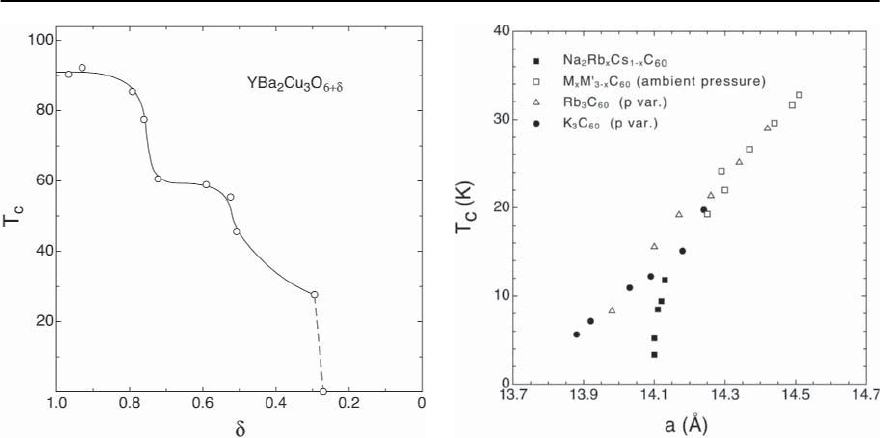
14 High-T
c
Superconductivity 777
Fig. 14.17.Variation of the critical temperature T
c
as a func-
tion of ı in YBa
2
Cu
3
O
6+ı
(see [66])
Bi-Based and Tl-Based Copper Oxides
Most of what is known about superconductivity of
the Bi-based compounds [67–69] is very similar to
what we have discussed in Sect. 14.3.2 concerning the
hole doped La-cuprates. Also here, underdoped and
overdoped regimes embrace the situation of optimal
doping, more or less independent of the maximum
value of T
c
which depends on the chemical compo-
sition of the compound, i.e., on the number of Cu-O
planes per unit cell.It is rather amazing that the max-
imum T
c
’s of the individual series of alloys ranges
from 15 to 125 K. Again it is observed that strong
overdoping eventually leads to the disappearance
of superconductivity. The corresponding data base
for superconducting Tl-based compounds [70–72] is
much less extensive but there is no evidence for a
significantly different behavior.
14.3.3 Fullerides
The secret of inducing superconductivity in these
types of materials is again doping, with electrons in
this case [73,74]. This is, e.g., achieved with the in-
troduction of various numbers, between 1 and 3, of
atoms of alkaline metal elements per unit cell. The
Fig. 14.18. Variation of the critical temperature T
c
of ful-
lerides as a function of the lattice parameter a,achieved
either by doping or by application of external pressure (p)
(see [45])
main result of numerous investigations is the dis-
tinct variation of the critical temperature with the
lattice parameter, seemingly a universal feature and,
with a few exceptions,independent of the chosen ma-
terial. An increase of the separation a of the atoms
leads to an enhancement of T
c
[75] and, vice versa,
areductionofT
c
upon applying external pressure
is observed [76]. This has been verified by changing
the lattice parameter both via variation of the chem-
ical composition and by applying external pressure.
A schematic representation of T(a) for a selection of
these materials is shown in Fig. 14.18. This plot sug-
geststhat an increaseof T
c
maybeachievedbysimply
enhancing the lattice parameter a.Slightdeviations
from a universal T(a) behavior under pressure have,
however, been reported [77,78]. Considering an ex-
tended set of data, and plotting T
c
/T
max
c
versus the
concentration n of valence electrons, whereby T
max
c
is the maximum critical temperature in a single al-
loy series, it has been claimed that the maxima of
all the considered T
c
’s is reached if n =3andthat
no superconductivityis observed if either n < 2.5or
n > 4.0 [79].The maximum value of the criticaltem-
perature reported for bulk material is that of Cs
3
C
60
,
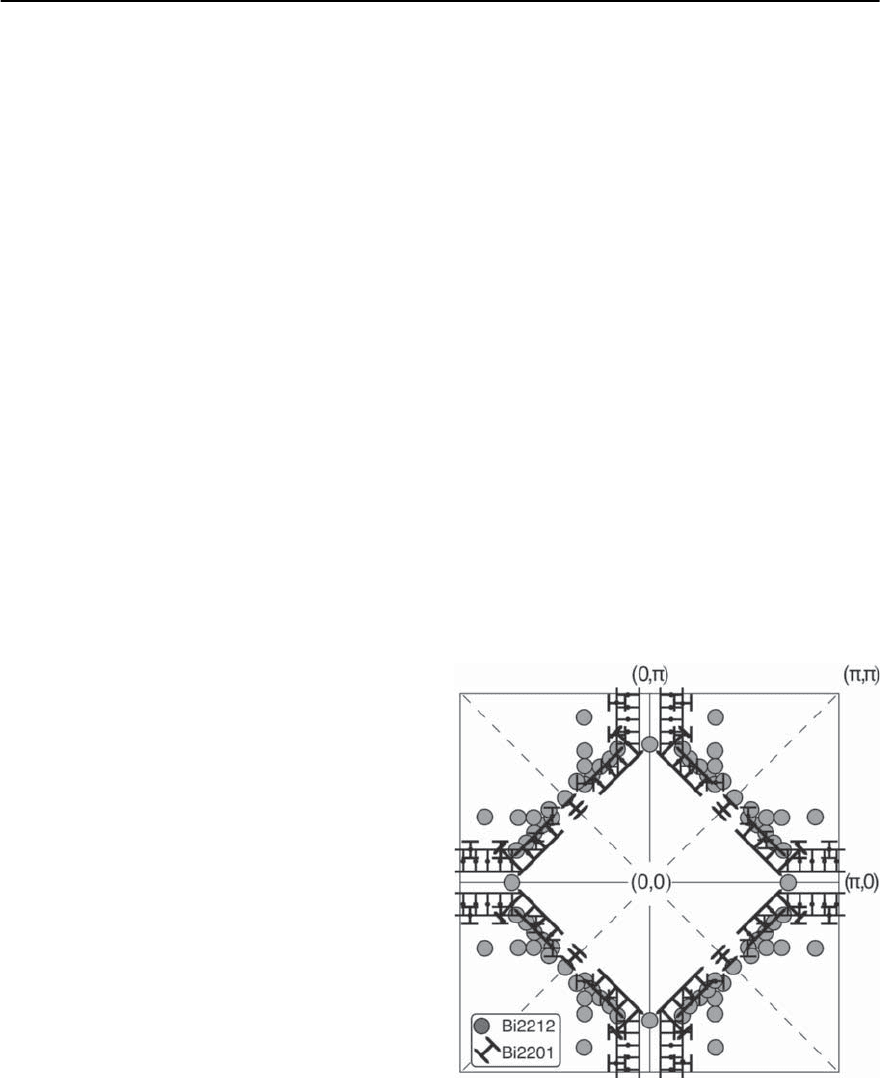
778 H.R.Ott
apparently a non cubic compound with a T
c
of about
40 K [80].
14.3.4 MgB
2
This compound does not seem to allow for large vari-
ations of the chemical composition without loosing
superconductivity [81]. So far it appears that the bi-
nary compound with the proper stoichiometry re-
veals the highest T
c
. Most attempts of alloying have
led to substantial reductions of T
c
and all other di-
borides with differentcationelementshave,so far,re-
sisted to exhibit superconductivity at similarly high
critical temperatures.An exception is Zn for which a
tiny enhancement of T
c
at low doping concentration
may have been observed [82,83].
14.4 Physical Properties of Copper Oxides
As we have indicated in the preceding section, the
general properties of the relevant cuprate com-
pounds and alloys depend crucially on the chem-
ical composition of the investigated materials. The
same is true for those materials that actually do
exhibit high-T
c
superconductivity.Already early re-
sults of measurements probing the physical proper-
ties of these materials indicated anomalous features
also in the normal state preceding the superconduct-
ing ground state and it soon became clear that the
occurrence of this superconductivity at unusually
high temperatures would not be explained without
a sound understanding of the character of the nor-
mal state [84]. It is for this reason that we also briefly
discuss those normal state properties that are diffi-
cult to understand on the basis of the very successful
Fermi liquid concept that has, in the past, been used
for describing the characteristic electronic proper-
ties of common metals. To keep this review tractable,
only few examples that are believed to capture the
essential issues of both the normal and the super-
conducting state of this type of materials are pre-
sented and discussed. Most of these examples, if they
are not intended to emphasize the influence of the
crystal structure or the chemical composition, are
chosen to represent those materials with so called
optimal doping, i.e., with the composition for which
amaximumT
c
has been observed. In these cases,
some evidence for the existence of a boundary in the
quasiparticle excitation spectrum that may be iden-
tified as a Fermi surface has been obtained from both
conventional [85] and angle resolved photoemission
spectroscopy (ARPES) [86,87] with high energy res-
olution. A schematic view of the cross sections of
the 3D Fermi surfaces of Bi cuprates, deduced from
ARPES measurements, is shown in Fig. 14.19. This
evidence is more obvious for overdoped materials
than it is for optimally doped or underdoped com-
pounds although more recently it has been claimed
that also for underdoped material, resolution limited
signals, indicating well defined quasiparticle excita-
tions, have been obtained [88]. Measurements with
further improved energy resolution, however, seem
to reveal that quasiparticle-type signals are only well
identified if the investigated material is in the su-
perconducting state [89]. It thus appears that it is
still unclear whether well defined quasiparticles do
exist in the normal state. At any rate, their manifes-
tation certainly depends on the doping level of the
material. As we shall see below, the difficulties en-
countered with the spectra of underdoped cuprates
may arise because of the formation of a pseudogap
Fig. 14.19. Mapping of the Fermi surface of Bi-based super-
conducting cuprates by ARPES (see [86])
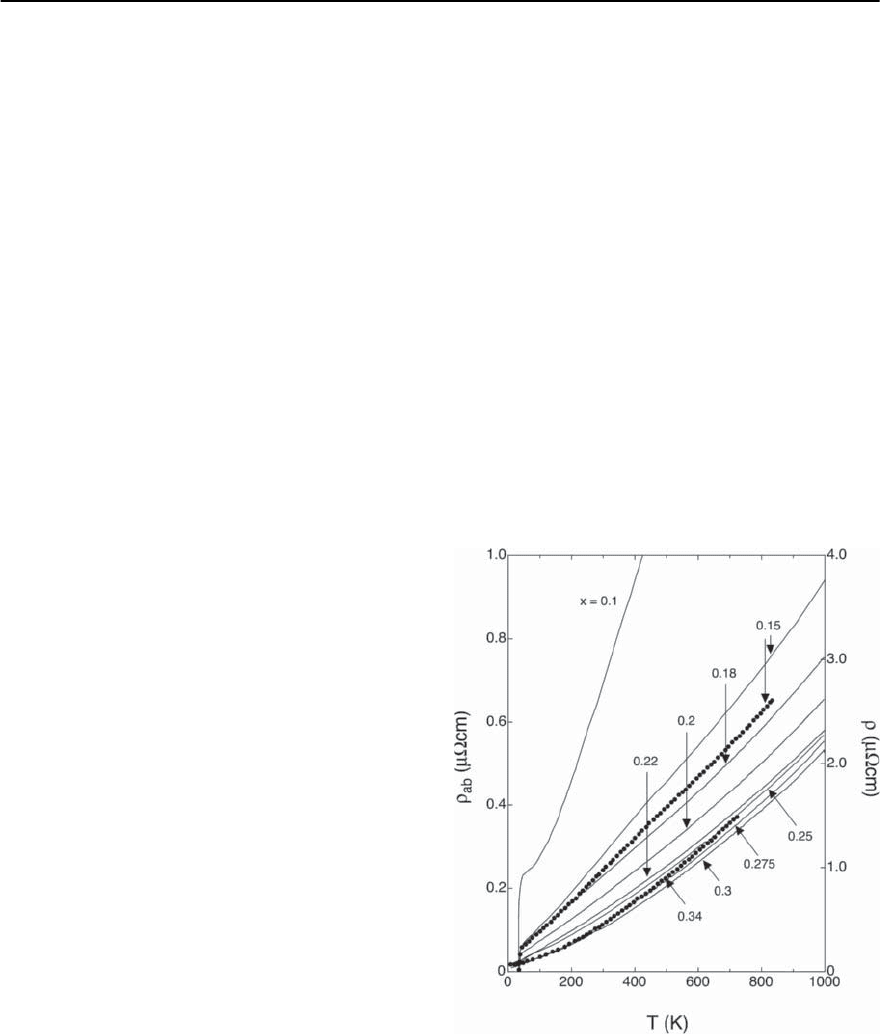
14 High-T
c
Superconductivity 779
in the quasiparticle excitation spectrum already in
the normal state of these materials.
In this context it is important to note that,because
of the particular crystal structures,featuringthe Cu-
O planes as the essential structural element, most
of the physical properties of these cuprates exhibit
distinct anisotropies.
14.4.1 Normal State Properties
The first indications of anomalous features of the
normal state of high-T
c
cuprates were provided by
measurements of the temperature dependence of
the electrical resistivity (T) [90] of some of these
materials, both parallel and perpendicular to the
Cu-O planes [91]. These early transport results were
confirmed in many cases and with improving sam-
ple quality, and complemented by additional data,
mainly concerning the thermal conductivity and the
Hall effect,both in the normal and the superconduct-
ing state.
Electrical Resist ivity
First it seems instructive to consider the varia-
tion of (T), measured for currents parallel to the
Cu-O planes, upon doping. A well studied case is
La
2−x
Sr
x
CuO
4
and some selected data are shown in
Fig. 14.20 [92]. What is amazing, is the strong tem-
perature dependence of the resistivity even at large
absolute values.The increasing concentration of hole
doping with increasing x is reflected in both the
magnitude of at room temperature and the slope
∂/∂T. Another typical feature is the extended re-
gion of the linear variation of with temperature for
x ≤ 0.18. For common metals, the linear in T vari-
ation of the resistivity is restricted to temperatures
around 200 K or above, but usually is not observed
much below 100 K.It may also be seen that for higher
doping levels, this particular feature is lost and the
change of (T) with increasing x is much less pro-
nounced than for lower values of x.Consideringthat
the maximum value of T
c
for this compound series
is reached at optimal doping with x ≈ 0.15, (T)is
clearly anomalous in what has been termed the un-
derdoped regime and progressively adopts a more
common behavior in the so called overdoped region.
This linear proportionality of the resistivity with re-
spect to the temperature is one of the common fea-
tures of the normal state of cuprate superconductors,
most clearly borne out in the underdoped regime.
An important case in this respect is the compound
Bi
2
Sr
2
CuO
6
(Bi2201) where the linear in T variation
of may be observed from low temperatures, be-
cause T
c
is only of the order of 10 K,up to 700 K [93].
The persistence of this temperature dependence of
or, equivalently, of the scattering rate
−1
of the elec-
tronic quasiparticles down to T
c
,is taken as evidence
for an anomalous metallic state, not compatible with
expectations of the Fermi liquid model, where a T
2
dependence of
−1
is expected. In particular, the ab-
sence of any onset of residual resistance, definitely
expected to be visible if the absolute magnitude of
the measured values of are considered, is difficult
to understand.
Another unusual feature of the electrical resistiv-
ity is the generally observed large anisotropies and
Fig. 14.20. Temperature dependence of the electrical resis-
tivityof La
2−x
Sr
x
CuO
4
in polycrystalline form (solid lines)
and for currents in the basal (ab) plane of singlecrystalline
films (see [92])
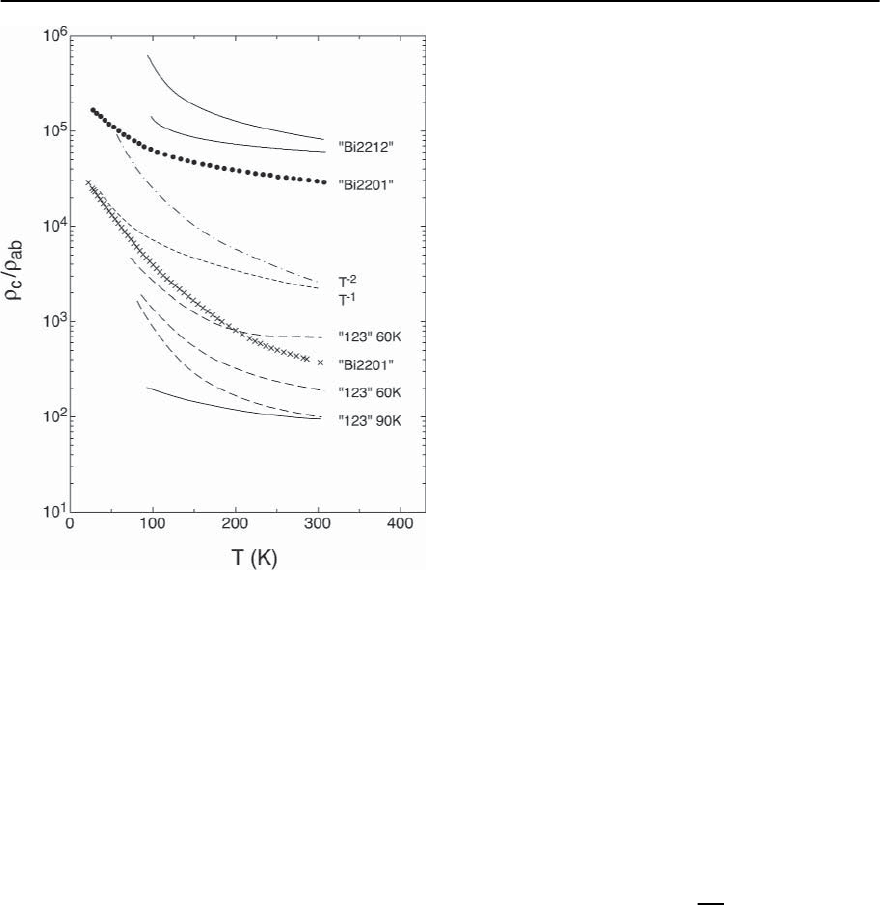
780 H.R.Ott
Fig. 14.21. Temperature variation of the ratio of
c
and
ab
for various cuprate superconductors. The general trend for
T
−1
and T
−2
behavior is also indicated (see, e.g., [94])
their temperature dependences if the resistivities are
measured either parallel or perpendicular to the Cu-
O planes [94].Asmay be expected, these anisotropies
are strongly influenced by details of the crystal struc-
ture and examples are shown in Fig. 14.21. These
large anisotropies imply that the motion ofthe quasi-
particles is confined to the Cu-O planes and that they
tend to localize in the motion perpendicular to it.
The localization of quasiparticles in only one direc-
tion cannot occur in a Fermi liquid and therefore
the observed anisotropies indicate the failure of the
Fermi liquid model for describing the metallic state
of cuprates above T
c
, at least in the underdoped and
optimally doped regime. Large anisotropies, as those
of the electrical conductivities,are also observed in
many other, physically relevant parameters. This has
led to the notion that at least electronically, these
cuprates should be regarded as quasi-two dimen-
sional systems. This view has guided many theoreti-
cal attempts to understand the physical properties of
these materials.
The Hall effect
Already early experiments [95] indicated anomalous
features of the Hall response in the normal state
of cuprate superconductors, exhibiting a strong in-
creaseof theHall coefficientR
H
with decreasing tem-
perature above T
c
. The Hall resistivity
xy
and the
Hall constant R
H
are related via
xy
= R
H
· H , (14.1)
where His the externally applied magnetic field.Var-
ious later experiments confirmed this trend and ex-
periments made with single-crystalline samples of
YBa
2
Cu
3
O
7−x
(YBCO) revealed that the Hall con-
stant, for currents parallel to the Cu-O planes and
external magnetic fields oriented perpendicularly to
these planes, is positive and varies as T
−1
[96]. The
out of plane Hall constant, however, obtained for the
arrangement that both the current and the field di-
rection are in the plane but perpendicular to each
other, providing a Hall field E
H
along the c direction
of the crystal lattice, remained constant and nega-
tive between 400 K and T
c
[97]. As an example for
the distinct temperature dependence of the in plane
Hall constant we show, in Fig. 14.22, R
−1
H
versus T,
measured on single crystalline samples of YBCO-123
and Bi
2
Sr
2
CaCu
2
O
8
(Bi2212) [98].Equally intriguing
is the temperature dependence of cotŸ
H
=
xx
/
xy
which, as demonstrated in Fig. 14.23, varies almost
as T
2
over a wide temperature range [97, 98]. The
in-plane Hall angle is defined as
Ÿ
H
= arctg
xy
xx
. (14.2)
These two phenomena, apparently quite universal
for high-T
c
copper oxides, were interpreted by An-
derson [99] to provide evidence for the anomalous
features of the electronic ensemble in these cuprates.
He argued that the electronic transport properties
appear to be those of a two-dimensional Luttinger
liquid,rather than those of a Fermi liquid. In essence
there are two different scattering rates,
−1
tr
and
−1
H
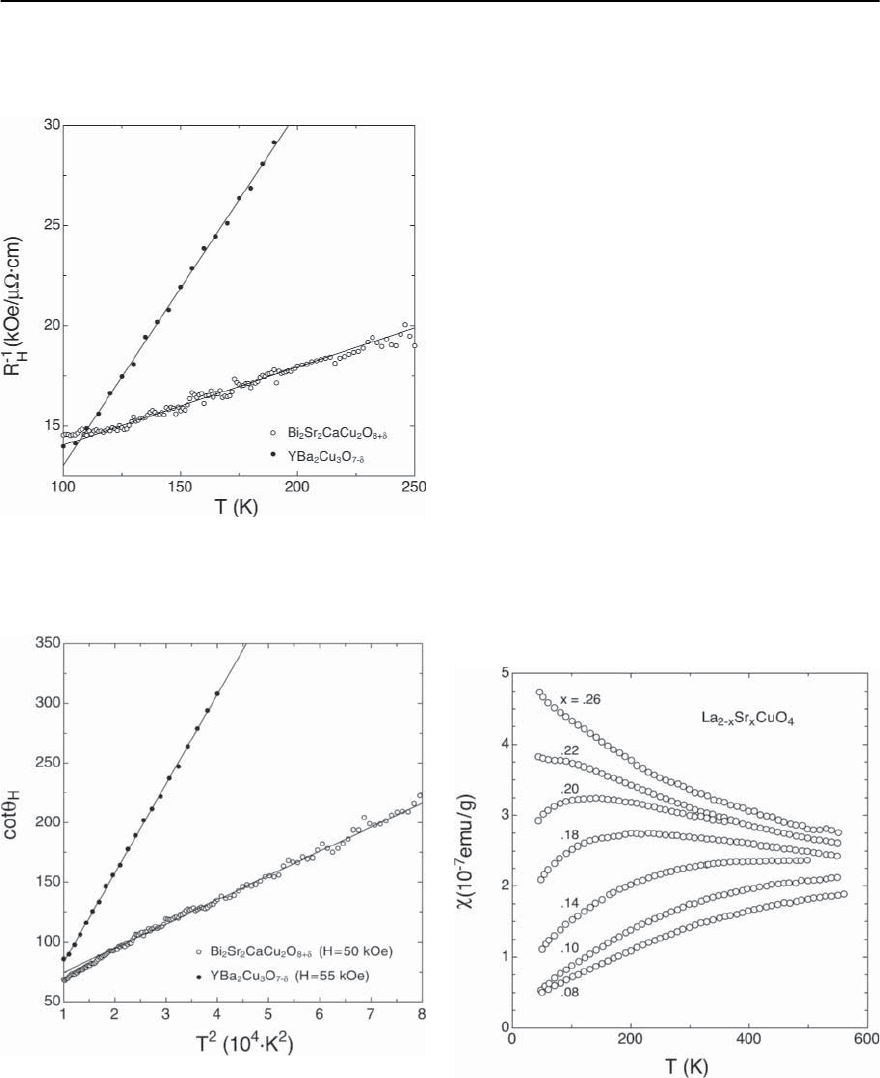
14 High-T
c
Superconductivity 781
that have to be considered. The longitudinal trans-
port scattering rate is
−1
tr
∼ T,asimpliedby(T)
discussed aboveandfor the transverse scattering rate
Fig. 14.22. Temperature dependence of the in plane
Hall constant of single crystalline YBa
2
Cu
3
O
7
and
Bi
2
Sr
2
CaCu
2
O
8
in the form of R
−1
H
vs T
Fig. 14.23. TemperaturedependenceoftheinplaneHallan-
gle Ÿ of single crystalline YBa
2
Cu
3
O
7
and Bi
2
Sr
2
CaCu
2
O
8
in the form of cotŸ versus T
2
−1
H
, in this model representing the intrinsic scatter-
ing rate for quasiparticle-like excitations of the Lut-
tinger liquid, so called spinons, a T
2
dependence is
predicted. If, in addition, impurities are considered,
the model predicts that cotŸ
H
= aT
2
+ C,where
a is a constant and C increases with increasing im-
purity content. This predicted behavior has actually
also been verified experimentally, supporting again
the view that the normal state of these cuprates is
quite different from that of a common metal.
Magnetic Susceptibility
The temperature dependence of the bulk magnetic
susceptibility (T) is very much dependent on the
doping concentration. This may well be seen in
Fig. 14.24, where (T)ofaseriesofLa
2−x
Sr
x
CuO
4
compounds with varying x is displayed. While for
low doping, ∂/∂T is positive across the whole cov-
ered temperature range, we note the appearance of
a maximum in (T) with increasing Sr content x,
the maximum shifting to lower temperatures with
increasing x.Asimilarbehaviorof(T)withvary-
ing doping concentration was also observed for the
YBCO series, where also in the underdoped regime,
a strong decrease of with decreasing temperature
Fig. 14.24. Temperature dependence of the normal state
magnetic susceptibility of La
2−x
Sr
x
CuO
4
(see [8])
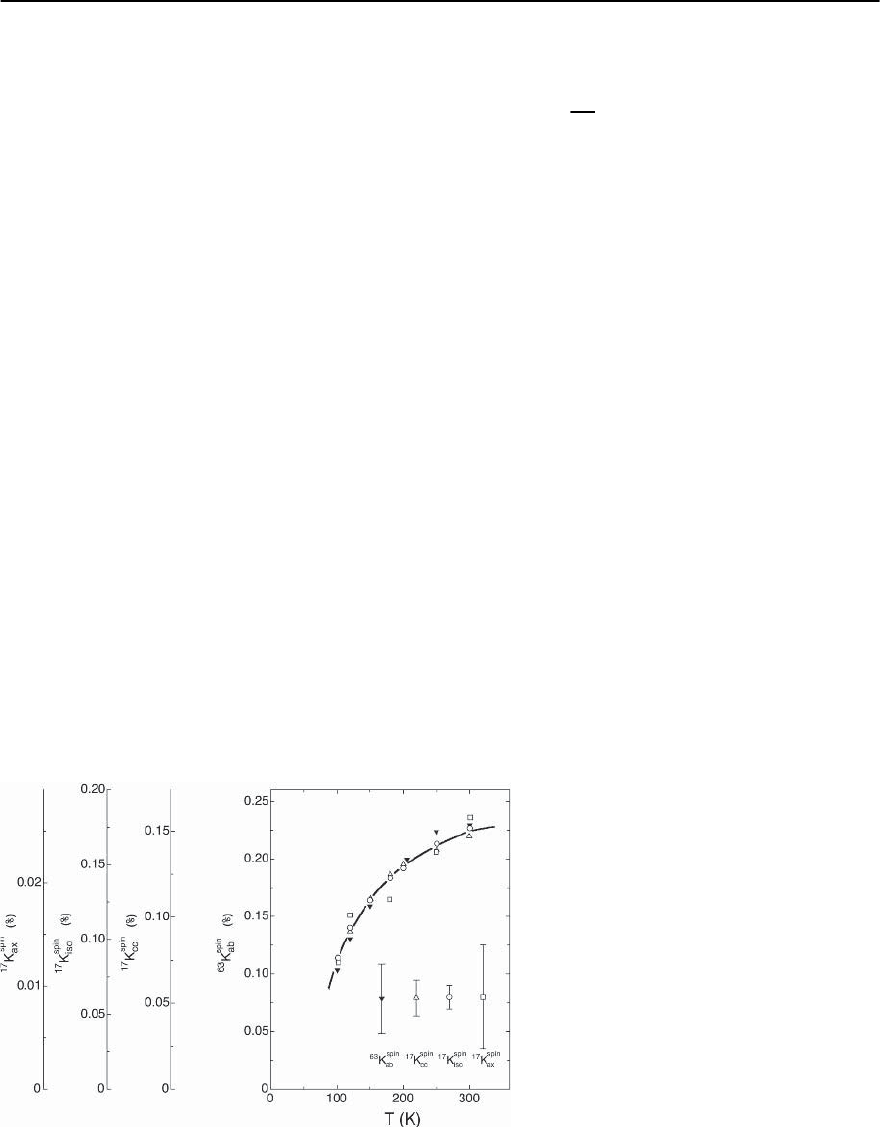
782 H.R.Ott
was observed.Naturally there are many ways to com-
pare these experimental data with model calcula-
tions but it seems clear that a simple description in-
voking only a Pauli-type electronic magnetic suscep-
tibility,which is a measure of the electronic density
of states at the Fermi energy D(E
F
), usually inde-
pendent of temperature, is not appropriate. The low
temperature negative slope ∂/∂T indicates a loss of
magnetic degrees of freedom with decreasing tem-
perature and in retrospect, these measurements of
(T) gave the first hint of a phenomenon that is still
of high current interest: the opening of a pseudo-
gap in the quasiparticle excitation spectrum, possi-
bly due to the formation of pairs in some incoherent
fashion, at temperatures distinctly above T
c
.Aswe
shall discuss in more detail below, a lot of additional
experimental evidence for the formation of a pseudo-
gap or,in other words,a loss of degrees of freedom in
the quasiparticle excitation spectrum, has since been
accumulated.
NMR: Knight Shift, Spin-LatticeRelaxation
In common metals the NMR response in the normal
state is, to a large extent, dictated by the presence
of conduction electrons. First, they provoke a shift
of the resonance signal, the well known Knight shift
K = H/H
0
,whereH
0
is the resonance field for
the nuclear spins in a non metallic environment, and
H is the shift in magnetic field if the resonance is
probed at constant frequency. In simple metals, K is
given by [100]
K =
8
3
· < |u
k
(0)|
2
> ·
P
, (14.3)
hence is related to the spin susceptibility of the con-
duction electrons
p
=2
2
B
D(E
F
) , (14.4)
and therefore expected to be essentially temperature
independent. Second, the conduction electrons also
dominate the spin-lattice relaxation process, leading
to a Korringa-type behavior of the relaxation rate
T
−1
1
,suchthat(T
1
T)
−1
is approximately constant.
This so called Korringa constant is related to the
Knight shift via
(T
1
T)
−1
∼ K
2
. (14.5)
It is notat all surprisingthat distinct deviationsfrom
these types of behavior have been identified in NMR
studies of the cupratematerials.Complications arise,
particularly in the evaluation of the Knight shift, be-
cause in structurally and electronically complicated
materials, such as the cuprates, this shift is the result
of various different contributions,also involving or-
bital degrees of freedom. Since NMR is a local probe,
the response of different nuclei occupying different
lattice sites may be probed and all the results have to
be interpreted by taking into account the local envi-
ronment of chosen species of nuclei.For the cuprates,
Fig. 14.25. Temperature dependence of various
components of the magnetic Knight shift of Cu
and O NMR signals in YBa
2
Cu
4
O
8
(see [101])
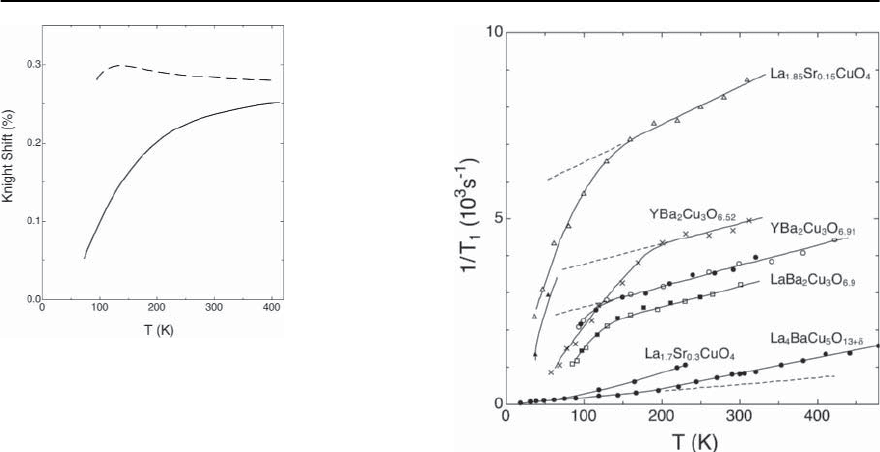
14 High-T
c
Superconductivity 783
Fig. 14.26. Average temperature dependence of the mag-
netic shift of the NMR signals probing the nuclei on planar
Cu sites of YBa
2
Cu
3
O
7
(broken line)andYBa
2
Cu
4
O
8
(solid
line) (see [102])
the bulk of data has been obtained from nuclei of Cu
and O isotopes.
First of all, there are clear cases where the Knight
shift exhibits a strong temperature dependence, not
really surprising if we recall the behavior of (T)
mentioned above.Examples of different components
of K(T) are shown in Fig. 14.25. Here, these K com-
ponents have been evaluated for Cu and O nuclei
in the compound YBa
2
Cu
4
O
8
(YBCO-124) [101]. It
is obvious that these different shift components are
substantially reduced with decreasing temperature
below 300 K, i.e., at temperatures far above T
c
.Sim-
ilar observations were made in NMR experiments
probing underdoped YBCO and Bi-2212. The situa-
tion is quite different, if K is measured in optimally
or overdoped material. In Fig. 14.26 we show this
difference schematically for the planar Cu nuclei in
YBCO-123 and YBCO-124 [102]. It is now accepted
that the strong temperature dependence of K is re-
lated with the low doping of the corresponding ma-
terials and most likely also reflects the quasi-gap in
the excitation spectrum mentioned above.
It turns out that also the different experimental
data concerning the temperature dependence of the
spin-lattice relaxationrateT
−1
1
(T) are not compatible
with the simplest expectations for a metal. Examples
of experimental results [103] for the relaxation rate,
measured for
63
Cu nuclei on planar Cu sites in var-
Fig. 14.27. Temperature dependence of
63
Cu NMR spin lat-
tice relaxation rates for nuclei on planar Cu sites in differ-
ent copper oxide compounds. The solid lines are to guide
the eye and the broken lines indicate the Korringa-type
variation,depending linearly on T (see [103])
ious cuprates at temperatures above the respective
critical temperatures, are shown in Fig. 14.27. For
comparison, the data for superconducting and non
superconducting Cu oxides are shown. First we note
that the relaxation is much faster in those materials
which exhibit high-T
c
superconductivity. It may also
be seen that the relaxation in the non superconduct-
ing compounds is indeed of Korringa-type,atleast at
low temperatures. This is clearly not the case for the
superconducting compounds. At elevated tempera-
tures, the relaxation rate is rather well approximated
by T
−1
1
= D + cT, indicating at least two relaxation
channels. While the second contribution may be in-
terpreted as representing some sort of Korringa re-
laxation,the first and temperature independent term
has to be associated with another contribution,most
likely due to the dynamics of localized d-electron
spins on the Cu atoms. If the Korringa-type term is
subtracted from the experimental T
−1
1
values, the re-
sulting d-electron contributions,shownin Fig. 14.28,
areobtained[103].A temperatureindependent relax-
ation rate may be related with fluctuations of local-
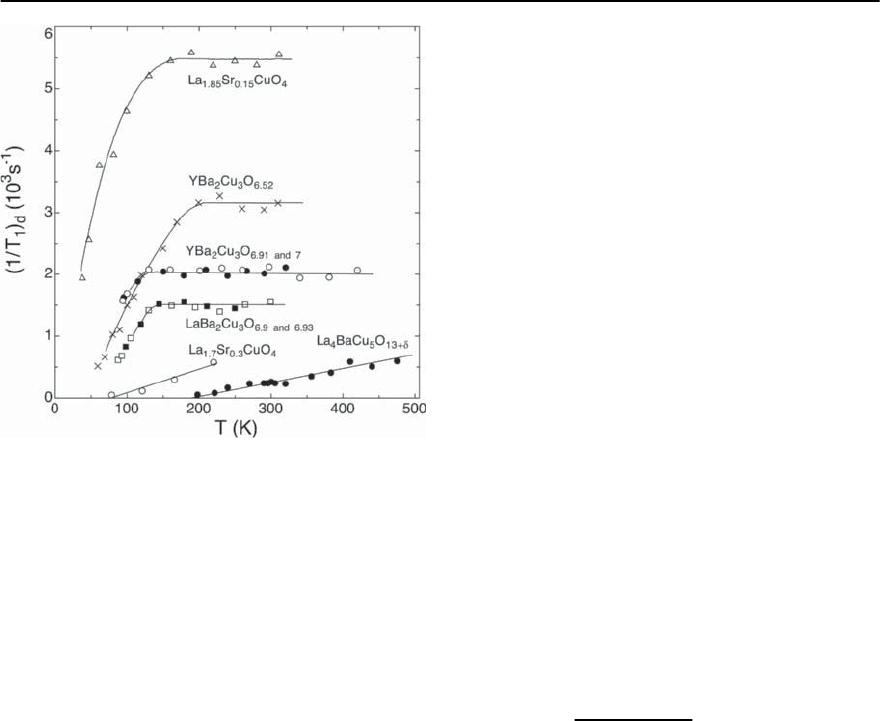
784 H.R.Ott
Fig. 14.28. Same data as in Fig. 14.27, after subtraction
of the Korringa type contribution varying linearly with
temperature, as indicated by the broken lines in Fig. 14.27.
These data are interpreted as representing the relaxation
due to Cu d electrons. The solid lines aretoguidetheeye
(see [103])
ized spins but may also be accountedfor byspin-den-
sity fluctuationsin relation with a 2D Fermi surface.
Fig. 14.28, however, reveals that also this contribu-
tion suffers from a temperature dependent reduc-
tion, starting well above the corresponding critical
temperatures, at least in some cases. It seems quite
reasonable to ascribe this feature again to the pres-
ence of the pseudo gap discussed above. By now it is
clear that the onset temperature of this gap forma-
tion tends to grow with decreasing doping.
Specific Heat
Theoutstandingproblemin connection withthespe-
cific heat of copper oxide superconductors in the nor-
mal state is the evaluation of the electronic contribu-
tion to the total specific heat C
tot
(T), which in the
range of T
c
is completely dominated by the specific
heat due to lattice excitations.The lattice specific heat
C
ph
(T) may be estimated by measurements of C
tot
(T) of one particular material in external magnetic
fields or, in an attempt to only change the electronic
contribution,by slightly changing the chemical com-
position, such as to vary the doping level. In both
cases it has to be assumed, that C
ph
(T) is unaffected
by these measures, not easy to verify in a rigorous
way. The electronic part C
el
(T), i.e., (C
tot
− C
ph
)(T)
is usually assumed to be proportional to T or, in
other words, it is assumed that the ratio C
el
/T is
agoodmeasurefortheelectronicspecificheatpa-
rameter . For the formal representation of C
ph
(T),
various approximation procedures have been sug-
gested and a number of relevant articles discuss this
issue [104,105]. For optimally doped YBCO-123 an
average and reasonable value for the electronic pa-
rameter in the normal state is =25mJ/moleK
2
.
For Bi-based copper oxides, the corresponding mo-
lar values for are somewhat smaller but still of the
order of 10 mJ/moleK
2
.Asweshallseebelow,thesit-
uation is more complicated in underdoped material
where C
el
/T is not a constant in the normal state. In
comparison with simple metals, the value quoted
above seems fairly large but still, the corresponding
density of electronic states D(E
F
)isnotexception-
ally high in order to justify the high values of T
c
in a
straightforward manner.
A common way to estimate the value is based on
the weak coupling BCS relation [106]
(C
el
s
− C
el
n
)(T
c
)
C
el
n
(T
c
)
=1.43 , (14.6)
where C
el
n
(T
c
)= · T
c
, and experimental data con-
cerning the specific heat anomaly at T
c
. Since this
approachis validonly for mean-field type transitions
and the weak coupling limit, most of these calcula-
tions may serve as order of magnitude estimates at
most. As we shall see below, none of the transitions
in high-T
c
cuprates is really of mean-field type and
in most cases the characteristics of the transition are
really quitedifferent,mainly because of rather strong
fluctuation effects.In addition and complicating the
situation,strong coupling effects are indicated by ex-
perimentally determined ratios of the and T
c
and
therefore the use of Eq. (14.6) for estimating the
parameter is more than questionable.
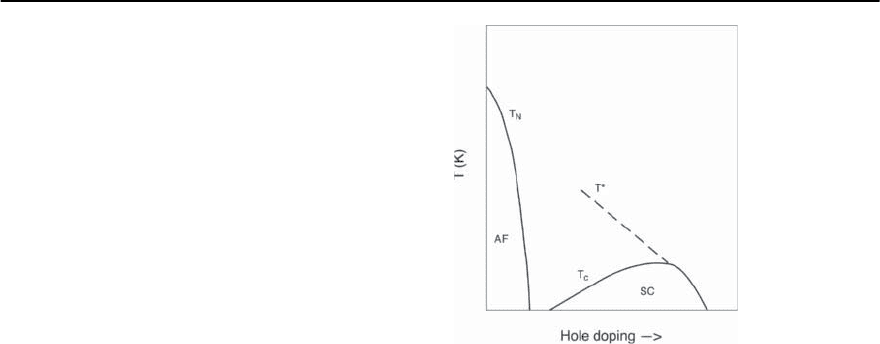
14 High-T
c
Superconductivity 785
Characteristics of the Normal State
From this brief compilation of some anomalies that
are encountered in the results of measurements of
some selected physical quantities, it may safely be
concluded, that very simple approaches, usually em-
ployed for the description of common metals, are
inadequate for treating the features of these cuprate
materials. Various theoretical attempts to cope with
these problems are the subject of other chapters in
this treatise and are discussed in more detail there.
Some of them start with the notion that the conven-
tional Fermi liquid model for describingthe metallic
normal state has to be abandonedhere and that other
quasiparticle-like excitations have to be introduced.
Many of the experimental facts mentioned above and
others, not considered here, seem to justify this view.
What is particularly hard to grasp, however, is the
fact that the character of these excitations seems to
vary with the doping level. There is not much doubt
that a common quasiparticle picture is adequate for
describing the properties of overdoped materials but
it is still much debated how the underdoped regime
should be treated. Here, the appearance of the of-
ten quoted pseudogap,to be discussed in some more
detail in the next subsection, adds another compli-
cation to the state of affairs. If finally it should turn
out that the electronic properties across the entire
doping range where superconductivity occurs may
still be understood on the basis of the Fermi liquid
model, a lot of additional input concerning details of
that model is probably needed.
Pseudogap, Additional Evidence
In this subsection we are briefly discussing addi-
tional experimental evidence for the pseudogap in
thenormal stateof cupratesuperconductors.Wehave
chosen results of experiments whose interpretation
leads to conclusions that are somewhat controversial.
This should serve the purpose to indicate that these
issues have not yet been settled completely. To set
the stage we display a schematic phase diagram for
the cuprate superconductors, where also the doping
dependence of T
∗
, the temperature below which ex-
perimental evidence for the presence of a pseudogap
exists, in Fig. 14.29.
Fig. 14.29. Schematic low temperature phase diagram of
cuprate superconductors. Emphasized are the antiferro-
magnetically ordered phase at low doping, the supercon-
ducting phase and the approximate location of T
∗
(x), indi-
cating the pseudogap formation
First we mention the results of specific heat mea-
surements [107], covering the temperature range
above and below T
c
of a series of samples of
Y
0.8
Ca
0.2
Ba
2
Cu
3
O
7−ı
with different oxygen contents,
i.e., varying parameter ı. This choice of material al-
lows to extend the overdoped regime for YBCO-123
type material; optimal doping conditions are reached
for ı ∼ 0.32. In Fig. 14.30 we show the temperature
dependence of theelectronic specificheatof different
samples in the form of C
el
/T. The electronic contri-
bution has been obtained by subtracting the lattice
contribution from the raw experimental data in an
apparently controlled way [108].In Fig.14.30a it may
be seen that in the normal state of overdoped ma-
terial, C
el
/T is temperature independent above the
respectivecritical temperatures and also does not de-
pend on ı. The upturns, appearing somewhat above
T
c
,most likely reflect fluctuationcontributionsto C
el
.
At this point of our discussion we do not address the
temperature dependence of C
el
at very low temper-
atures, leaving this point to be addressed in another
section below. The situation is completely different
for underdoped material. Here, as may be seen in
Fig.14.30b, the different C
el
/T versus T plots start to
diverge above T
c
in a manner that C
el
/T decreases
with decreasing T if ı > 0.5,thus indicating a loss of
entropy already above the onset of superconductiv-

786 H.R.Ott
ity, distinctly different from the behavior displayed
in Fig. 14.30a. An additional clear difference in the
(b) panel of the figure is the sudden drop in the peak
height of C
el
/T for ı > 0.32, although no corre-
sponding large change in T
c
is observed. In [109], a
detailed discussion of the temperature dependence
of the related entropies and of similar data, obtained
for a series of La
2−x
Sr
x
CuO
4
compounds,leads to the
conclusion that the pseudogap phenomenon should
not be regarded as being due to a precursor forma-
tion of Cooper pairs and therefore is not related with
the gap opening in the superconducting state.In par-
ticular it is argued that the pseudogap related loss
of low-energy normal state spectral weight actually
weakens the superconducting condensate. To some
extent this is compatible with the fact that contrary
to the decrease of T
c
with decreasing doping, the on-
set temperature T
∗
increases.
A quite different view has been obtained from
ARPES experimentson single crystals of underdoped
Fig. 14.30. Temperature dependence of the electronic spe-
cific heat of Y
0.8
Ca
0.2
Ba
2
Cu
3
O
7−ı
in the overdoped (a) and
underdoped (b) regime (see [107])
Bi-2212. With this type of experiments it has been
possible to map the Fermi surface of this type of ma-
terials and, because of much improved energy res-
olutions, to verify the onset of the gap related with
the superconducting ground state. A detailed pre-
sentation and discussion of ARPES experiments on
high-T
c
superconductors is given elsewhere in this
compendium. Nevertheless we note here that mea-
surements of this type of material mentioned above
and as a function of temperature reveal that a gap
signature at E
F
in different directions of k space ap-
pears at different temperatures.In this sense,the data
indicate a gradual loss of Fermi surface with de-
creasing temperature, starting well above T
c
[110].
The evolution, ending in the gap features of the su-
perconducting state below T
c
appears to be smooth
and therefore, it is concluded that the gap forma-
tion in the normal state is most likely due to a pre-
cursor pairing of quasiparticles, i.e., definitely re-
lated with the appearance of superconductivity be-
low T
c
[111].A schematic view ofthe temperaturede-
pendent shrinking of the Fermi surface in k-space is
displayed in Fig.14.31,indicatingthat the pseudogap
in the normal state and the finally resulting gap of
the superconducting state reveal the same anisotropy
in k-space. A k-dependent incoherent pairing is, of
course, not compatible with conventional supercon-
ductivity, where the instability of the whole Fermi
surface occurs at once at T
c
. Results of the same kind
of experiments on some overdoped material were
interpreted as to confirm the previously established
view of the absence of a pseudogap above T
c
[88].
Traditionally, various kinds of tunneling exper-
iments have been instrumental for qualitative and
quantitative measurements of gaps in electronic
Fig. 14.31. Schematic representation of the growth of the
Fermi surface of Bi-2212 with increasing temperature, as
obtained from ARPES experiments (see [110])
